Marketing Strategies of Nonprofit Organisations and FMCG Companies
VerifiedAdded on 2020/03/04
|13
|2960
|150
Report
AI Summary
This report examines the marketing strategies of various organizational groups, including nonprofit organizations like WWF, and FMCG companies such as Nestle, Unilever, and P&G. It analyzes the marketing concepts applied by WWF, focusing on its partnerships and collaborations. The report further investigates product launches by Nestle, examining their success factors and target markets. A comparative analysis of Unilever, P&G, and Nestle is conducted, considering market segmentation and competitive positioning. Additionally, the report explores the impact of demographic trends on international marketing opportunities, with a focus on emerging markets and the implications for FMCG companies. Recommendations are provided to enhance the marketing strategies of the discussed companies, including product line extensions and pricing adjustments. The report highlights the importance of understanding consumer behavior, market segmentation, and competitive dynamics in the context of both nonprofit and for-profit organizations.
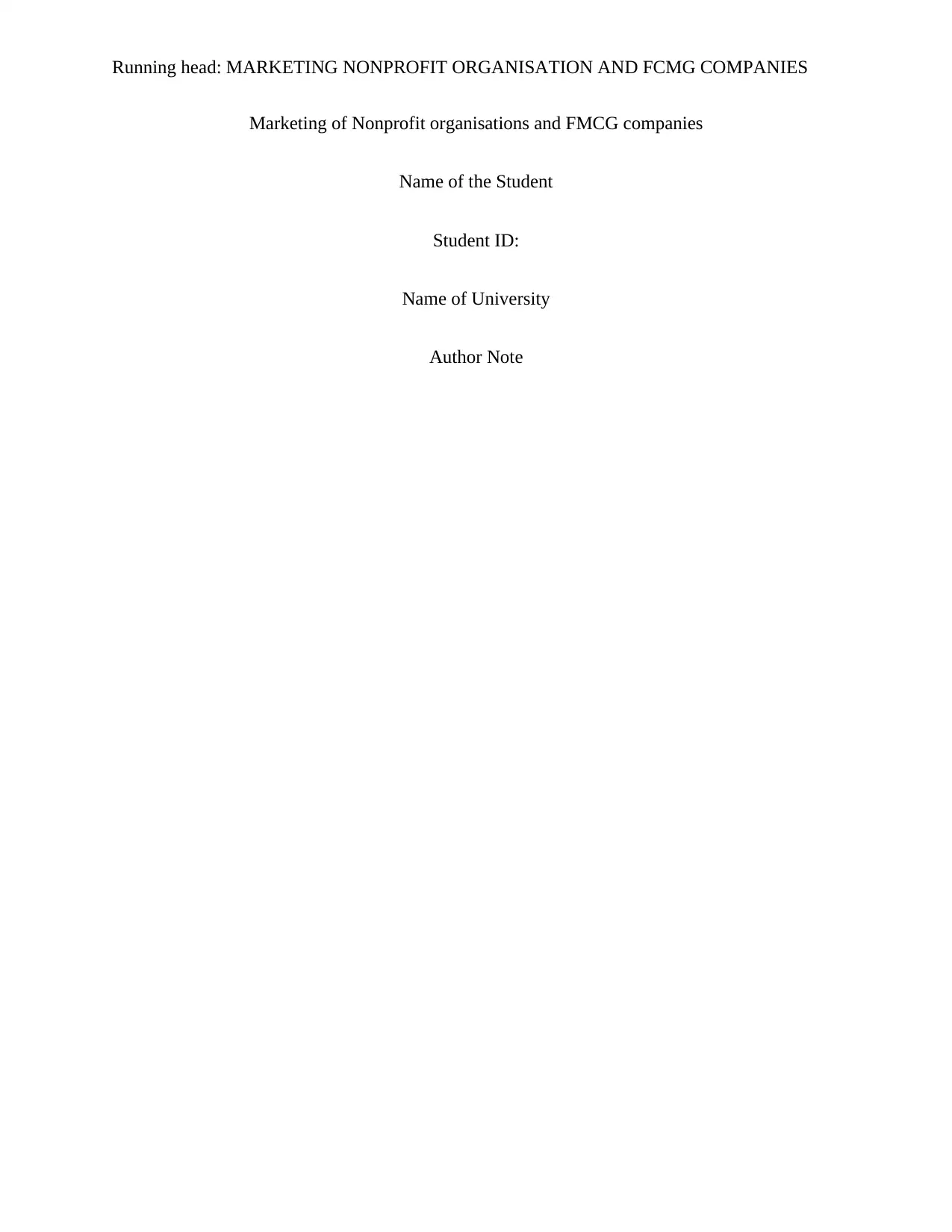
Running head: MARKETING NONPROFIT ORGANISATION AND FCMG COMPANIES
Marketing of Nonprofit organisations and FMCG companies
Name of the Student
Student ID:
Name of University
Author Note
Marketing of Nonprofit organisations and FMCG companies
Name of the Student
Student ID:
Name of University
Author Note
Paraphrase This Document
Need a fresh take? Get an instant paraphrase of this document with our AI Paraphraser
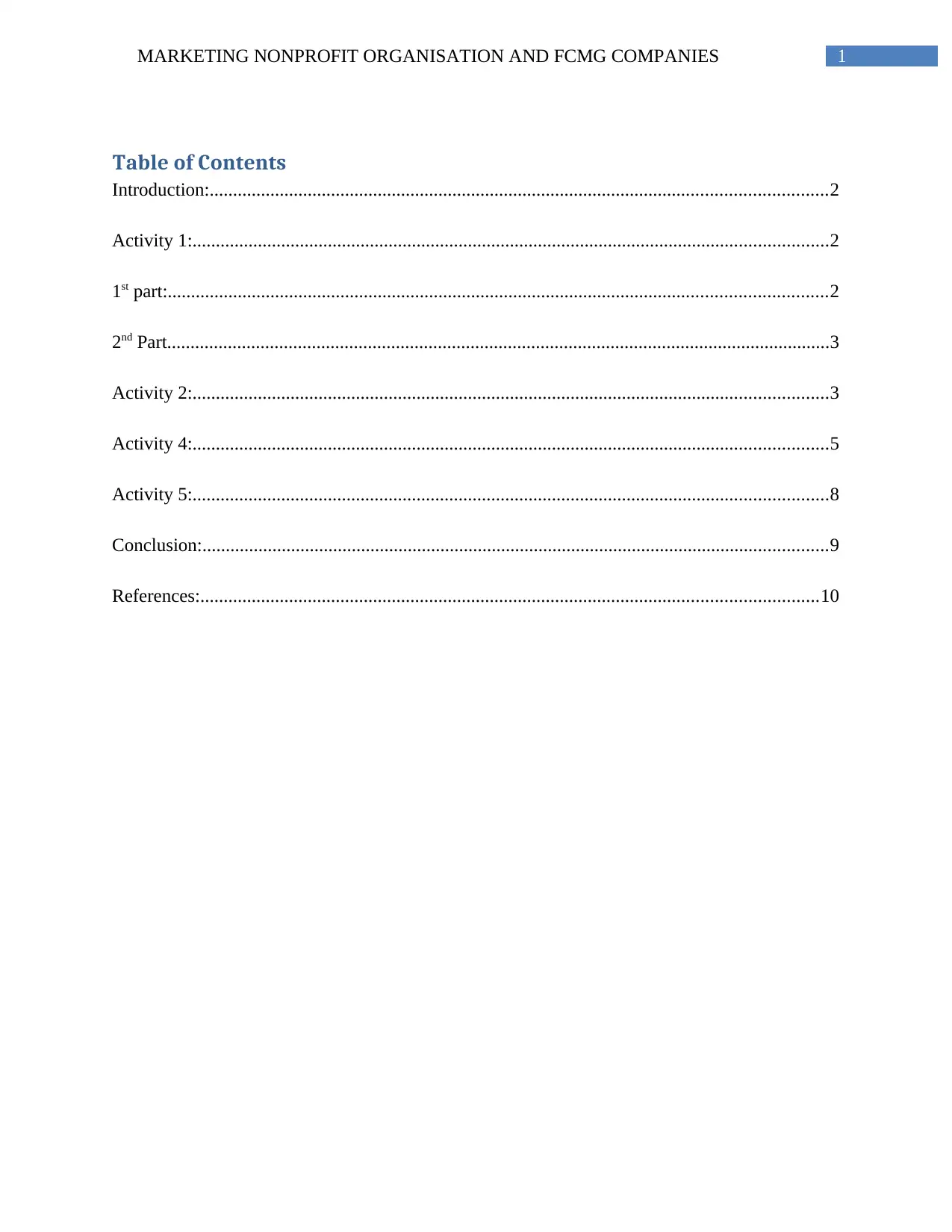
1MARKETING NONPROFIT ORGANISATION AND FCMG COMPANIES
Table of Contents
Introduction:....................................................................................................................................2
Activity 1:........................................................................................................................................2
1st part:.............................................................................................................................................2
2nd Part..............................................................................................................................................3
Activity 2:........................................................................................................................................3
Activity 4:........................................................................................................................................5
Activity 5:........................................................................................................................................8
Conclusion:......................................................................................................................................9
References:....................................................................................................................................10
Table of Contents
Introduction:....................................................................................................................................2
Activity 1:........................................................................................................................................2
1st part:.............................................................................................................................................2
2nd Part..............................................................................................................................................3
Activity 2:........................................................................................................................................3
Activity 4:........................................................................................................................................5
Activity 5:........................................................................................................................................8
Conclusion:......................................................................................................................................9
References:....................................................................................................................................10
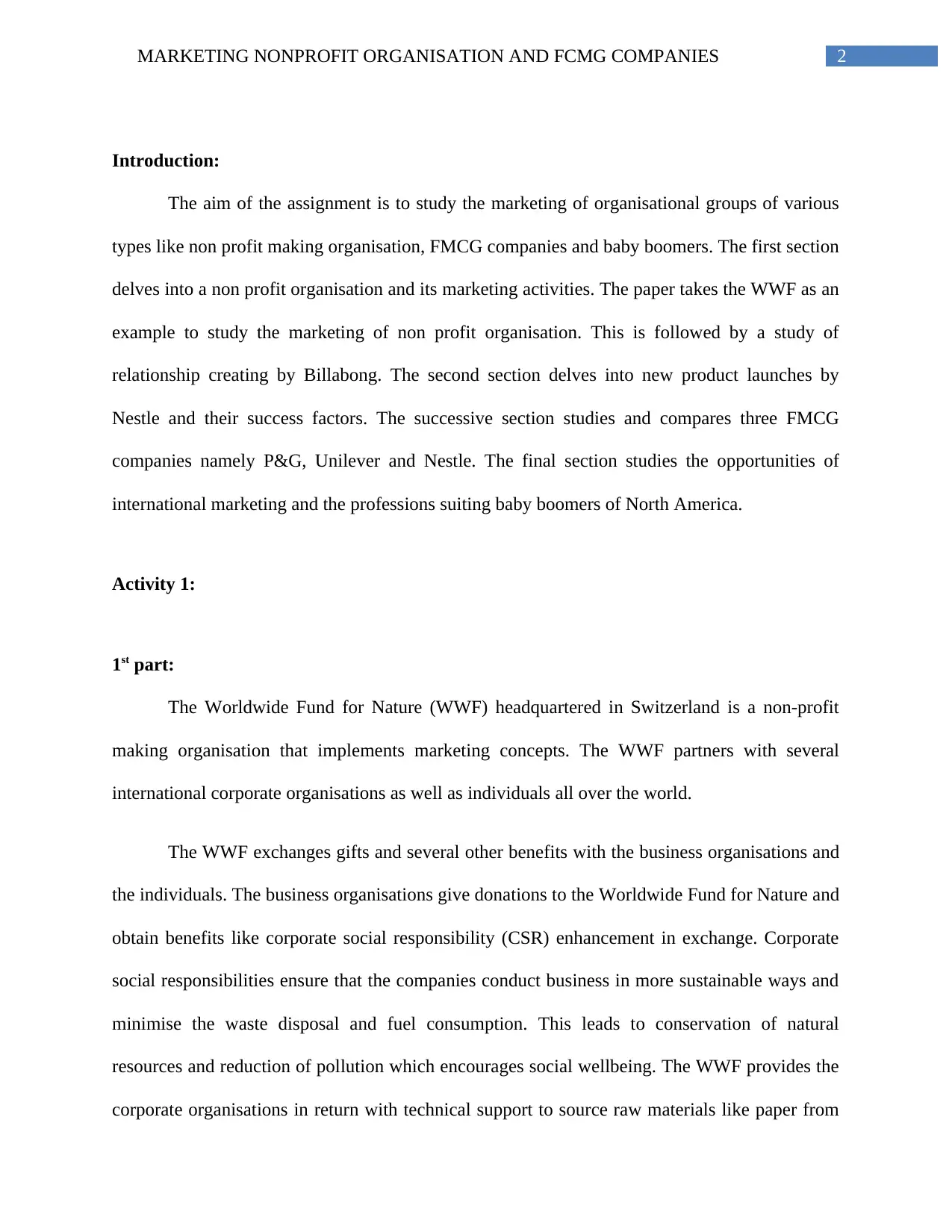
2MARKETING NONPROFIT ORGANISATION AND FCMG COMPANIES
Introduction:
The aim of the assignment is to study the marketing of organisational groups of various
types like non profit making organisation, FMCG companies and baby boomers. The first section
delves into a non profit organisation and its marketing activities. The paper takes the WWF as an
example to study the marketing of non profit organisation. This is followed by a study of
relationship creating by Billabong. The second section delves into new product launches by
Nestle and their success factors. The successive section studies and compares three FMCG
companies namely P&G, Unilever and Nestle. The final section studies the opportunities of
international marketing and the professions suiting baby boomers of North America.
Activity 1:
1st part:
The Worldwide Fund for Nature (WWF) headquartered in Switzerland is a non-profit
making organisation that implements marketing concepts. The WWF partners with several
international corporate organisations as well as individuals all over the world.
The WWF exchanges gifts and several other benefits with the business organisations and
the individuals. The business organisations give donations to the Worldwide Fund for Nature and
obtain benefits like corporate social responsibility (CSR) enhancement in exchange. Corporate
social responsibilities ensure that the companies conduct business in more sustainable ways and
minimise the waste disposal and fuel consumption. This leads to conservation of natural
resources and reduction of pollution which encourages social wellbeing. The WWF provides the
corporate organisations in return with technical support to source raw materials like paper from
Introduction:
The aim of the assignment is to study the marketing of organisational groups of various
types like non profit making organisation, FMCG companies and baby boomers. The first section
delves into a non profit organisation and its marketing activities. The paper takes the WWF as an
example to study the marketing of non profit organisation. This is followed by a study of
relationship creating by Billabong. The second section delves into new product launches by
Nestle and their success factors. The successive section studies and compares three FMCG
companies namely P&G, Unilever and Nestle. The final section studies the opportunities of
international marketing and the professions suiting baby boomers of North America.
Activity 1:
1st part:
The Worldwide Fund for Nature (WWF) headquartered in Switzerland is a non-profit
making organisation that implements marketing concepts. The WWF partners with several
international corporate organisations as well as individuals all over the world.
The WWF exchanges gifts and several other benefits with the business organisations and
the individuals. The business organisations give donations to the Worldwide Fund for Nature and
obtain benefits like corporate social responsibility (CSR) enhancement in exchange. Corporate
social responsibilities ensure that the companies conduct business in more sustainable ways and
minimise the waste disposal and fuel consumption. This leads to conservation of natural
resources and reduction of pollution which encourages social wellbeing. The WWF provides the
corporate organisations in return with technical support to source raw materials like paper from
⊘ This is a preview!⊘
Do you want full access?
Subscribe today to unlock all pages.

Trusted by 1+ million students worldwide
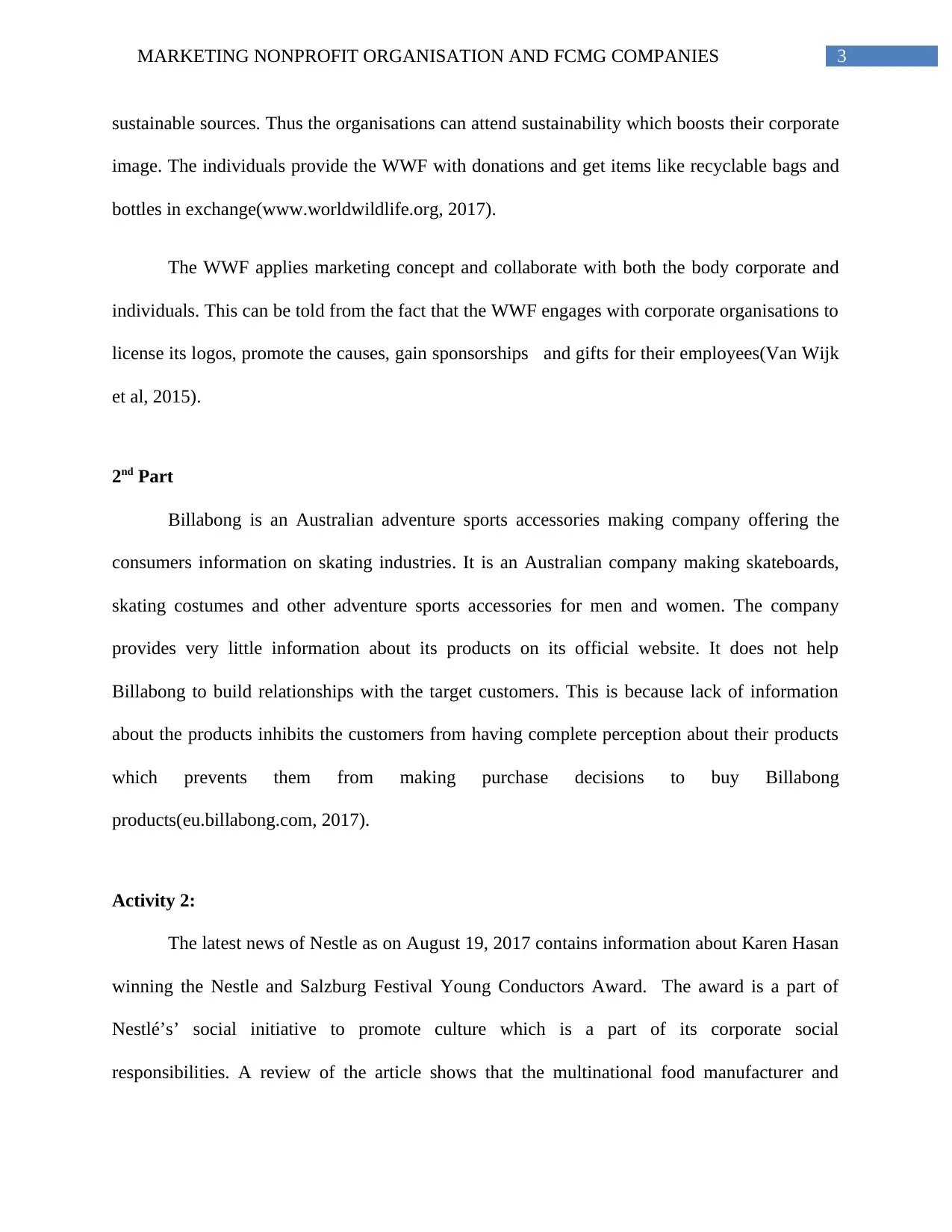
3MARKETING NONPROFIT ORGANISATION AND FCMG COMPANIES
sustainable sources. Thus the organisations can attend sustainability which boosts their corporate
image. The individuals provide the WWF with donations and get items like recyclable bags and
bottles in exchange(www.worldwildlife.org, 2017).
The WWF applies marketing concept and collaborate with both the body corporate and
individuals. This can be told from the fact that the WWF engages with corporate organisations to
license its logos, promote the causes, gain sponsorships and gifts for their employees(Van Wijk
et al, 2015).
2nd Part
Billabong is an Australian adventure sports accessories making company offering the
consumers information on skating industries. It is an Australian company making skateboards,
skating costumes and other adventure sports accessories for men and women. The company
provides very little information about its products on its official website. It does not help
Billabong to build relationships with the target customers. This is because lack of information
about the products inhibits the customers from having complete perception about their products
which prevents them from making purchase decisions to buy Billabong
products(eu.billabong.com, 2017).
Activity 2:
The latest news of Nestle as on August 19, 2017 contains information about Karen Hasan
winning the Nestle and Salzburg Festival Young Conductors Award. The award is a part of
Nestlé’s’ social initiative to promote culture which is a part of its corporate social
responsibilities. A review of the article shows that the multinational food manufacturer and
sustainable sources. Thus the organisations can attend sustainability which boosts their corporate
image. The individuals provide the WWF with donations and get items like recyclable bags and
bottles in exchange(www.worldwildlife.org, 2017).
The WWF applies marketing concept and collaborate with both the body corporate and
individuals. This can be told from the fact that the WWF engages with corporate organisations to
license its logos, promote the causes, gain sponsorships and gifts for their employees(Van Wijk
et al, 2015).
2nd Part
Billabong is an Australian adventure sports accessories making company offering the
consumers information on skating industries. It is an Australian company making skateboards,
skating costumes and other adventure sports accessories for men and women. The company
provides very little information about its products on its official website. It does not help
Billabong to build relationships with the target customers. This is because lack of information
about the products inhibits the customers from having complete perception about their products
which prevents them from making purchase decisions to buy Billabong
products(eu.billabong.com, 2017).
Activity 2:
The latest news of Nestle as on August 19, 2017 contains information about Karen Hasan
winning the Nestle and Salzburg Festival Young Conductors Award. The award is a part of
Nestlé’s’ social initiative to promote culture which is a part of its corporate social
responsibilities. A review of the article shows that the multinational food manufacturer and
Paraphrase This Document
Need a fresh take? Get an instant paraphrase of this document with our AI Paraphraser
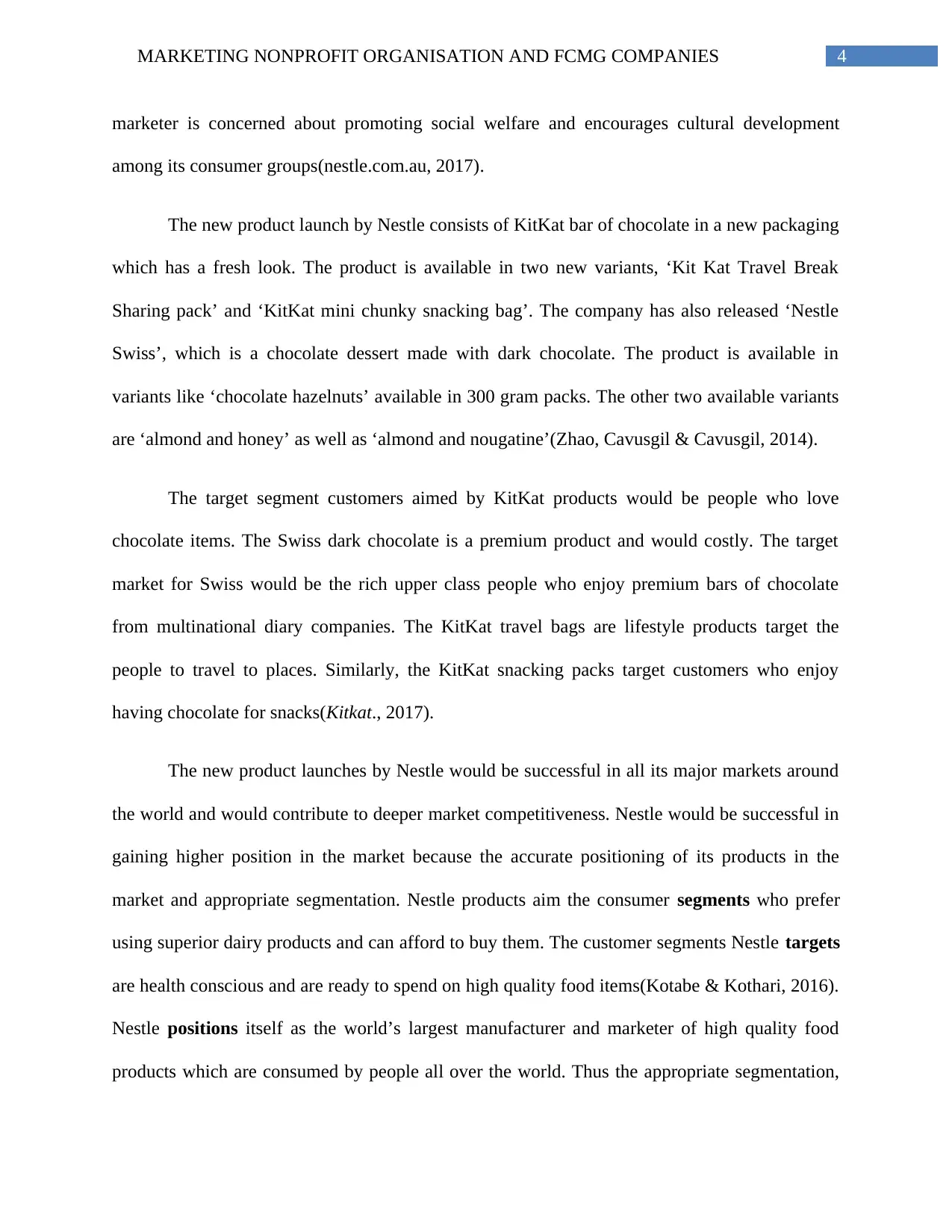
4MARKETING NONPROFIT ORGANISATION AND FCMG COMPANIES
marketer is concerned about promoting social welfare and encourages cultural development
among its consumer groups(nestle.com.au, 2017).
The new product launch by Nestle consists of KitKat bar of chocolate in a new packaging
which has a fresh look. The product is available in two new variants, ‘Kit Kat Travel Break
Sharing pack’ and ‘KitKat mini chunky snacking bag’. The company has also released ‘Nestle
Swiss’, which is a chocolate dessert made with dark chocolate. The product is available in
variants like ‘chocolate hazelnuts’ available in 300 gram packs. The other two available variants
are ‘almond and honey’ as well as ‘almond and nougatine’(Zhao, Cavusgil & Cavusgil, 2014).
The target segment customers aimed by KitKat products would be people who love
chocolate items. The Swiss dark chocolate is a premium product and would costly. The target
market for Swiss would be the rich upper class people who enjoy premium bars of chocolate
from multinational diary companies. The KitKat travel bags are lifestyle products target the
people to travel to places. Similarly, the KitKat snacking packs target customers who enjoy
having chocolate for snacks(Kitkat., 2017).
The new product launches by Nestle would be successful in all its major markets around
the world and would contribute to deeper market competitiveness. Nestle would be successful in
gaining higher position in the market because the accurate positioning of its products in the
market and appropriate segmentation. Nestle products aim the consumer segments who prefer
using superior dairy products and can afford to buy them. The customer segments Nestle targets
are health conscious and are ready to spend on high quality food items(Kotabe & Kothari, 2016).
Nestle positions itself as the world’s largest manufacturer and marketer of high quality food
products which are consumed by people all over the world. Thus the appropriate segmentation,
marketer is concerned about promoting social welfare and encourages cultural development
among its consumer groups(nestle.com.au, 2017).
The new product launch by Nestle consists of KitKat bar of chocolate in a new packaging
which has a fresh look. The product is available in two new variants, ‘Kit Kat Travel Break
Sharing pack’ and ‘KitKat mini chunky snacking bag’. The company has also released ‘Nestle
Swiss’, which is a chocolate dessert made with dark chocolate. The product is available in
variants like ‘chocolate hazelnuts’ available in 300 gram packs. The other two available variants
are ‘almond and honey’ as well as ‘almond and nougatine’(Zhao, Cavusgil & Cavusgil, 2014).
The target segment customers aimed by KitKat products would be people who love
chocolate items. The Swiss dark chocolate is a premium product and would costly. The target
market for Swiss would be the rich upper class people who enjoy premium bars of chocolate
from multinational diary companies. The KitKat travel bags are lifestyle products target the
people to travel to places. Similarly, the KitKat snacking packs target customers who enjoy
having chocolate for snacks(Kitkat., 2017).
The new product launches by Nestle would be successful in all its major markets around
the world and would contribute to deeper market competitiveness. Nestle would be successful in
gaining higher position in the market because the accurate positioning of its products in the
market and appropriate segmentation. Nestle products aim the consumer segments who prefer
using superior dairy products and can afford to buy them. The customer segments Nestle targets
are health conscious and are ready to spend on high quality food items(Kotabe & Kothari, 2016).
Nestle positions itself as the world’s largest manufacturer and marketer of high quality food
products which are consumed by people all over the world. Thus the appropriate segmentation,
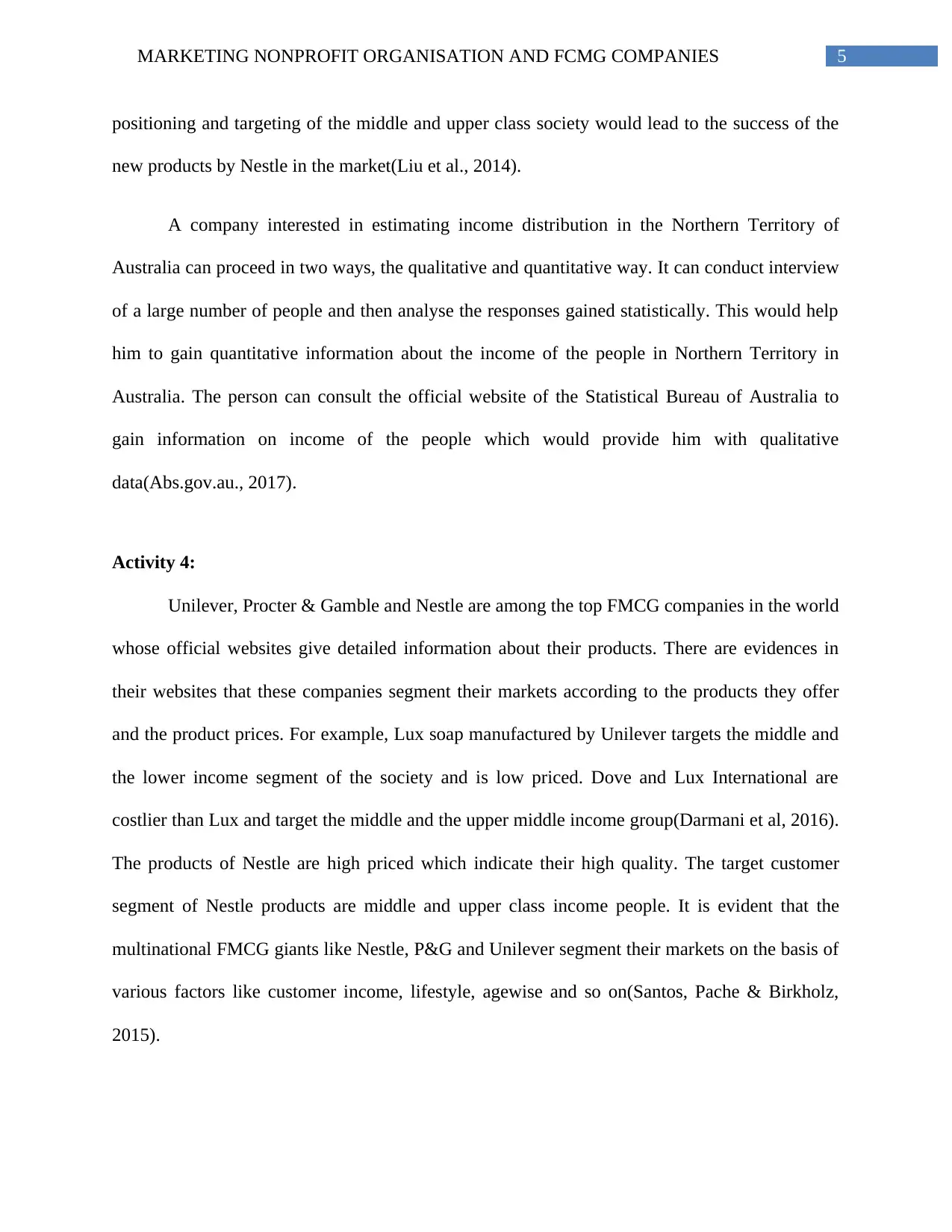
5MARKETING NONPROFIT ORGANISATION AND FCMG COMPANIES
positioning and targeting of the middle and upper class society would lead to the success of the
new products by Nestle in the market(Liu et al., 2014).
A company interested in estimating income distribution in the Northern Territory of
Australia can proceed in two ways, the qualitative and quantitative way. It can conduct interview
of a large number of people and then analyse the responses gained statistically. This would help
him to gain quantitative information about the income of the people in Northern Territory in
Australia. The person can consult the official website of the Statistical Bureau of Australia to
gain information on income of the people which would provide him with qualitative
data(Abs.gov.au., 2017).
Activity 4:
Unilever, Procter & Gamble and Nestle are among the top FMCG companies in the world
whose official websites give detailed information about their products. There are evidences in
their websites that these companies segment their markets according to the products they offer
and the product prices. For example, Lux soap manufactured by Unilever targets the middle and
the lower income segment of the society and is low priced. Dove and Lux International are
costlier than Lux and target the middle and the upper middle income group(Darmani et al, 2016).
The products of Nestle are high priced which indicate their high quality. The target customer
segment of Nestle products are middle and upper class income people. It is evident that the
multinational FMCG giants like Nestle, P&G and Unilever segment their markets on the basis of
various factors like customer income, lifestyle, agewise and so on(Santos, Pache & Birkholz,
2015).
positioning and targeting of the middle and upper class society would lead to the success of the
new products by Nestle in the market(Liu et al., 2014).
A company interested in estimating income distribution in the Northern Territory of
Australia can proceed in two ways, the qualitative and quantitative way. It can conduct interview
of a large number of people and then analyse the responses gained statistically. This would help
him to gain quantitative information about the income of the people in Northern Territory in
Australia. The person can consult the official website of the Statistical Bureau of Australia to
gain information on income of the people which would provide him with qualitative
data(Abs.gov.au., 2017).
Activity 4:
Unilever, Procter & Gamble and Nestle are among the top FMCG companies in the world
whose official websites give detailed information about their products. There are evidences in
their websites that these companies segment their markets according to the products they offer
and the product prices. For example, Lux soap manufactured by Unilever targets the middle and
the lower income segment of the society and is low priced. Dove and Lux International are
costlier than Lux and target the middle and the upper middle income group(Darmani et al, 2016).
The products of Nestle are high priced which indicate their high quality. The target customer
segment of Nestle products are middle and upper class income people. It is evident that the
multinational FMCG giants like Nestle, P&G and Unilever segment their markets on the basis of
various factors like customer income, lifestyle, agewise and so on(Santos, Pache & Birkholz,
2015).
⊘ This is a preview!⊘
Do you want full access?
Subscribe today to unlock all pages.

Trusted by 1+ million students worldwide
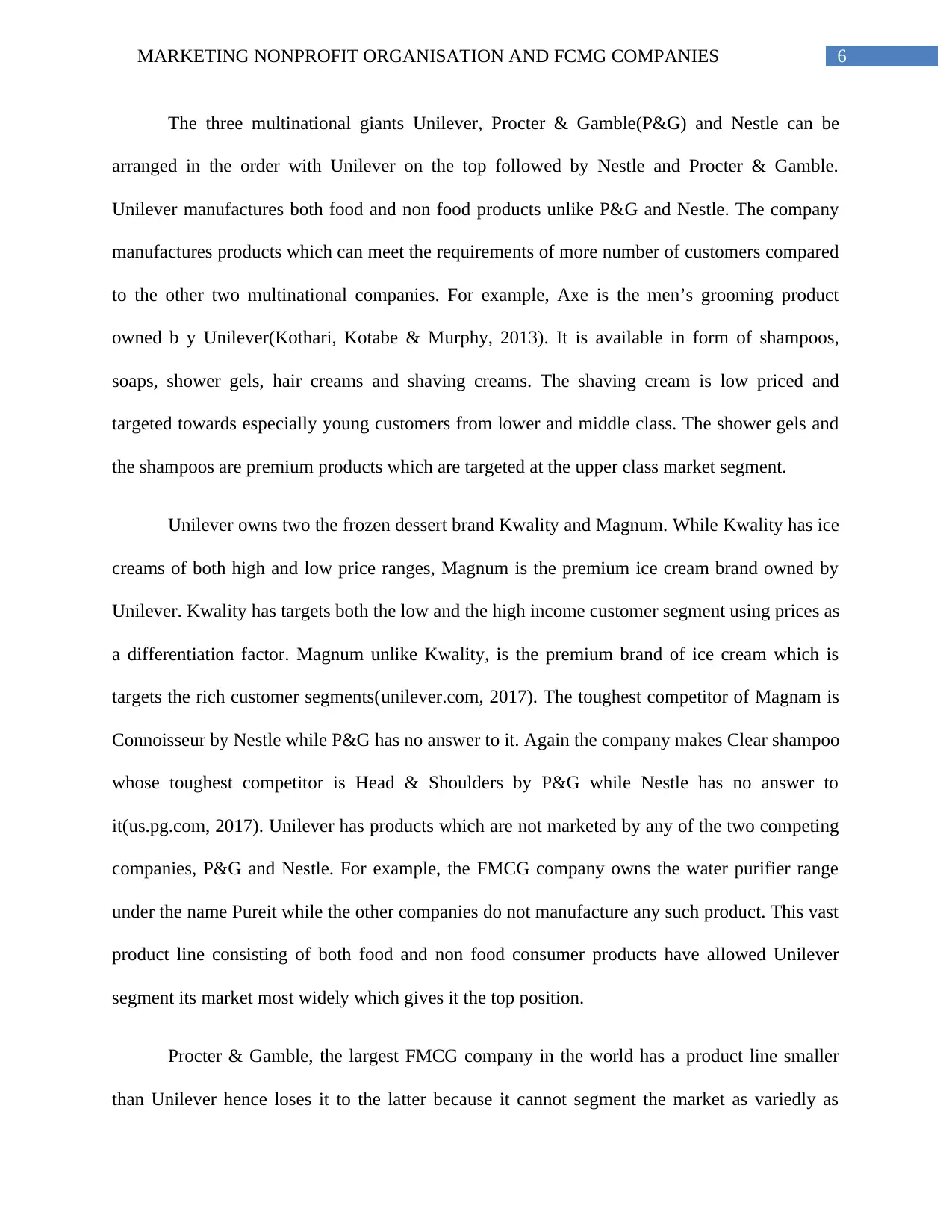
6MARKETING NONPROFIT ORGANISATION AND FCMG COMPANIES
The three multinational giants Unilever, Procter & Gamble(P&G) and Nestle can be
arranged in the order with Unilever on the top followed by Nestle and Procter & Gamble.
Unilever manufactures both food and non food products unlike P&G and Nestle. The company
manufactures products which can meet the requirements of more number of customers compared
to the other two multinational companies. For example, Axe is the men’s grooming product
owned b y Unilever(Kothari, Kotabe & Murphy, 2013). It is available in form of shampoos,
soaps, shower gels, hair creams and shaving creams. The shaving cream is low priced and
targeted towards especially young customers from lower and middle class. The shower gels and
the shampoos are premium products which are targeted at the upper class market segment.
Unilever owns two the frozen dessert brand Kwality and Magnum. While Kwality has ice
creams of both high and low price ranges, Magnum is the premium ice cream brand owned by
Unilever. Kwality has targets both the low and the high income customer segment using prices as
a differentiation factor. Magnum unlike Kwality, is the premium brand of ice cream which is
targets the rich customer segments(unilever.com, 2017). The toughest competitor of Magnam is
Connoisseur by Nestle while P&G has no answer to it. Again the company makes Clear shampoo
whose toughest competitor is Head & Shoulders by P&G while Nestle has no answer to
it(us.pg.com, 2017). Unilever has products which are not marketed by any of the two competing
companies, P&G and Nestle. For example, the FMCG company owns the water purifier range
under the name Pureit while the other companies do not manufacture any such product. This vast
product line consisting of both food and non food consumer products have allowed Unilever
segment its market most widely which gives it the top position.
Procter & Gamble, the largest FMCG company in the world has a product line smaller
than Unilever hence loses it to the latter because it cannot segment the market as variedly as
The three multinational giants Unilever, Procter & Gamble(P&G) and Nestle can be
arranged in the order with Unilever on the top followed by Nestle and Procter & Gamble.
Unilever manufactures both food and non food products unlike P&G and Nestle. The company
manufactures products which can meet the requirements of more number of customers compared
to the other two multinational companies. For example, Axe is the men’s grooming product
owned b y Unilever(Kothari, Kotabe & Murphy, 2013). It is available in form of shampoos,
soaps, shower gels, hair creams and shaving creams. The shaving cream is low priced and
targeted towards especially young customers from lower and middle class. The shower gels and
the shampoos are premium products which are targeted at the upper class market segment.
Unilever owns two the frozen dessert brand Kwality and Magnum. While Kwality has ice
creams of both high and low price ranges, Magnum is the premium ice cream brand owned by
Unilever. Kwality has targets both the low and the high income customer segment using prices as
a differentiation factor. Magnum unlike Kwality, is the premium brand of ice cream which is
targets the rich customer segments(unilever.com, 2017). The toughest competitor of Magnam is
Connoisseur by Nestle while P&G has no answer to it. Again the company makes Clear shampoo
whose toughest competitor is Head & Shoulders by P&G while Nestle has no answer to
it(us.pg.com, 2017). Unilever has products which are not marketed by any of the two competing
companies, P&G and Nestle. For example, the FMCG company owns the water purifier range
under the name Pureit while the other companies do not manufacture any such product. This vast
product line consisting of both food and non food consumer products have allowed Unilever
segment its market most widely which gives it the top position.
Procter & Gamble, the largest FMCG company in the world has a product line smaller
than Unilever hence loses it to the latter because it cannot segment the market as variedly as
Paraphrase This Document
Need a fresh take? Get an instant paraphrase of this document with our AI Paraphraser
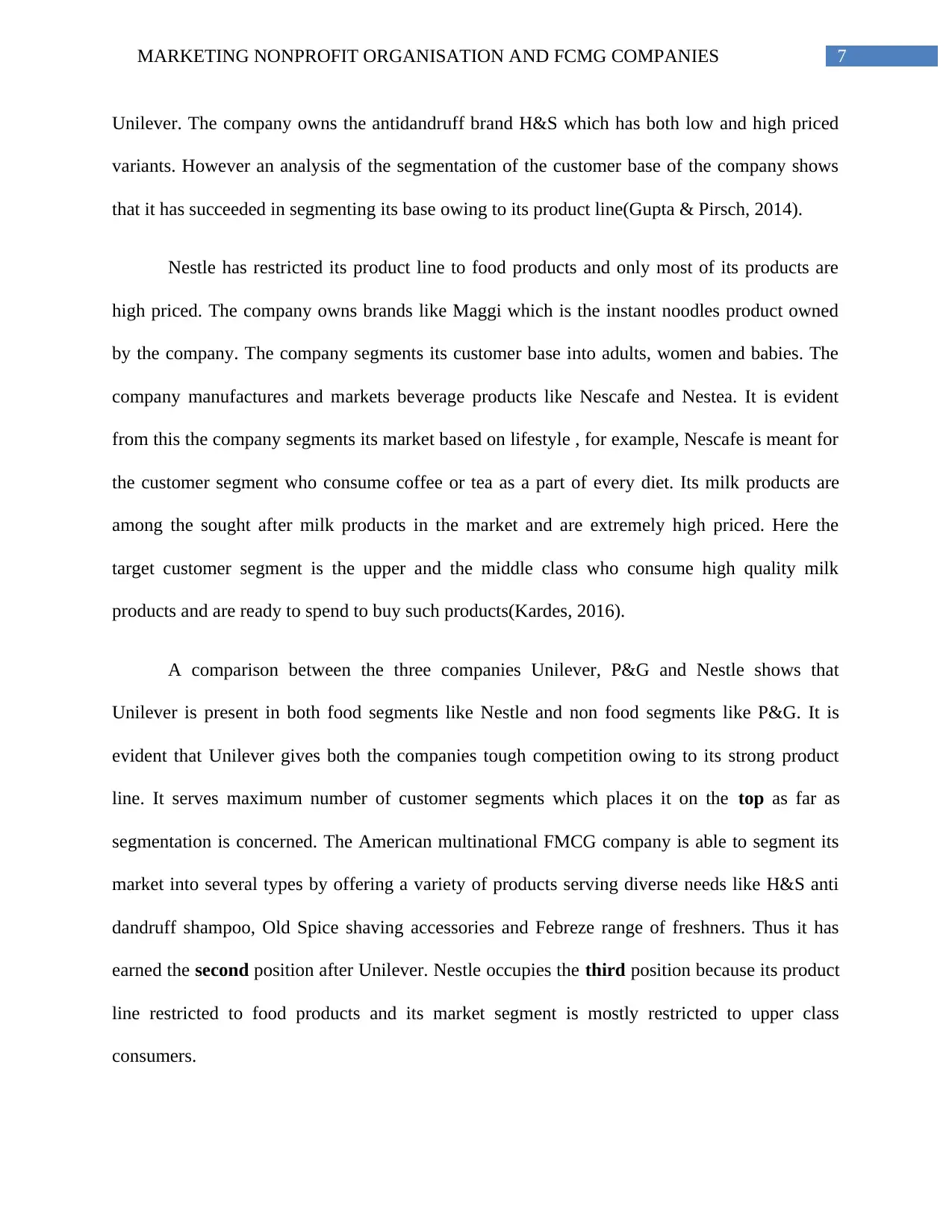
7MARKETING NONPROFIT ORGANISATION AND FCMG COMPANIES
Unilever. The company owns the antidandruff brand H&S which has both low and high priced
variants. However an analysis of the segmentation of the customer base of the company shows
that it has succeeded in segmenting its base owing to its product line(Gupta & Pirsch, 2014).
Nestle has restricted its product line to food products and only most of its products are
high priced. The company owns brands like Maggi which is the instant noodles product owned
by the company. The company segments its customer base into adults, women and babies. The
company manufactures and markets beverage products like Nescafe and Nestea. It is evident
from this the company segments its market based on lifestyle , for example, Nescafe is meant for
the customer segment who consume coffee or tea as a part of every diet. Its milk products are
among the sought after milk products in the market and are extremely high priced. Here the
target customer segment is the upper and the middle class who consume high quality milk
products and are ready to spend to buy such products(Kardes, 2016).
A comparison between the three companies Unilever, P&G and Nestle shows that
Unilever is present in both food segments like Nestle and non food segments like P&G. It is
evident that Unilever gives both the companies tough competition owing to its strong product
line. It serves maximum number of customer segments which places it on the top as far as
segmentation is concerned. The American multinational FMCG company is able to segment its
market into several types by offering a variety of products serving diverse needs like H&S anti
dandruff shampoo, Old Spice shaving accessories and Febreze range of freshners. Thus it has
earned the second position after Unilever. Nestle occupies the third position because its product
line restricted to food products and its market segment is mostly restricted to upper class
consumers.
Unilever. The company owns the antidandruff brand H&S which has both low and high priced
variants. However an analysis of the segmentation of the customer base of the company shows
that it has succeeded in segmenting its base owing to its product line(Gupta & Pirsch, 2014).
Nestle has restricted its product line to food products and only most of its products are
high priced. The company owns brands like Maggi which is the instant noodles product owned
by the company. The company segments its customer base into adults, women and babies. The
company manufactures and markets beverage products like Nescafe and Nestea. It is evident
from this the company segments its market based on lifestyle , for example, Nescafe is meant for
the customer segment who consume coffee or tea as a part of every diet. Its milk products are
among the sought after milk products in the market and are extremely high priced. Here the
target customer segment is the upper and the middle class who consume high quality milk
products and are ready to spend to buy such products(Kardes, 2016).
A comparison between the three companies Unilever, P&G and Nestle shows that
Unilever is present in both food segments like Nestle and non food segments like P&G. It is
evident that Unilever gives both the companies tough competition owing to its strong product
line. It serves maximum number of customer segments which places it on the top as far as
segmentation is concerned. The American multinational FMCG company is able to segment its
market into several types by offering a variety of products serving diverse needs like H&S anti
dandruff shampoo, Old Spice shaving accessories and Febreze range of freshners. Thus it has
earned the second position after Unilever. Nestle occupies the third position because its product
line restricted to food products and its market segment is mostly restricted to upper class
consumers.
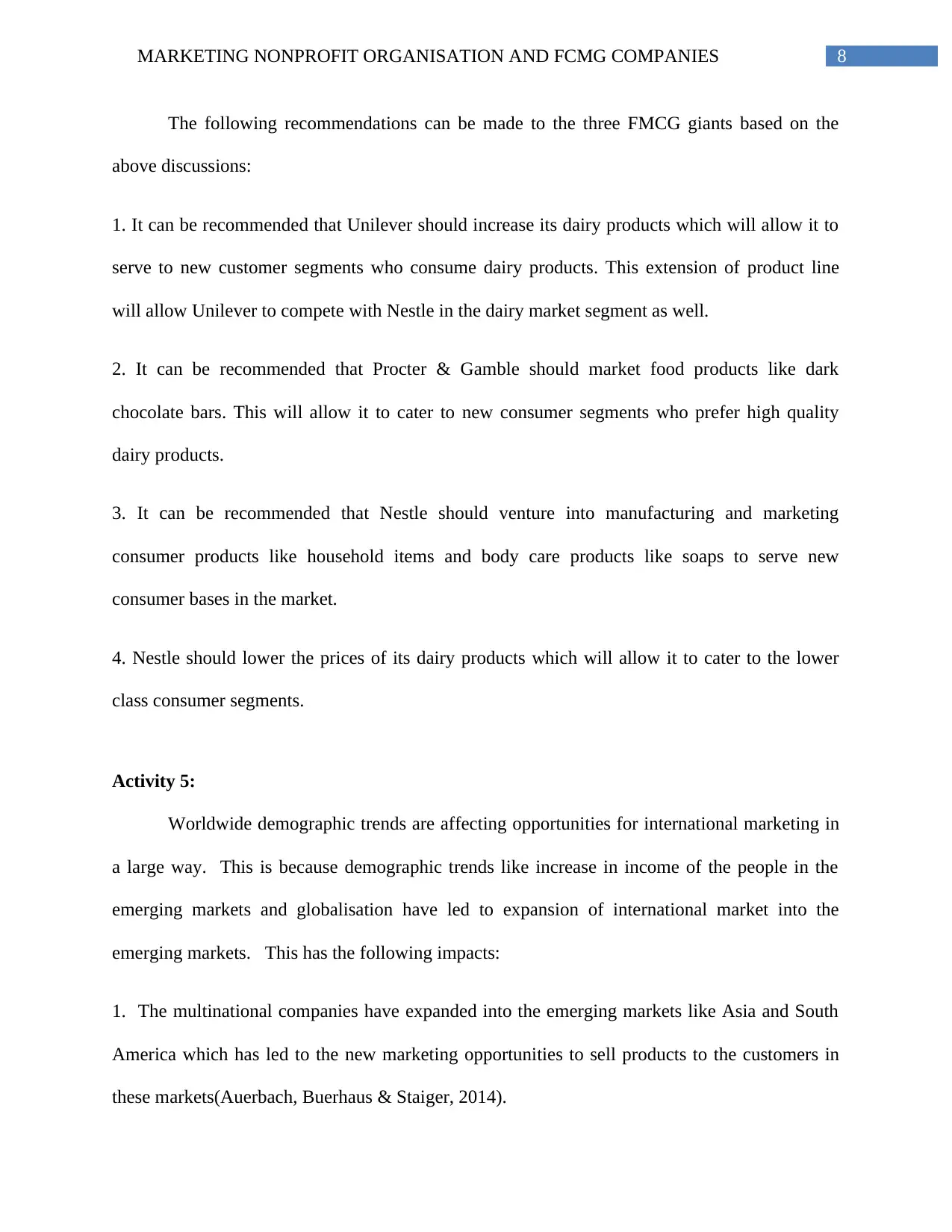
8MARKETING NONPROFIT ORGANISATION AND FCMG COMPANIES
The following recommendations can be made to the three FMCG giants based on the
above discussions:
1. It can be recommended that Unilever should increase its dairy products which will allow it to
serve to new customer segments who consume dairy products. This extension of product line
will allow Unilever to compete with Nestle in the dairy market segment as well.
2. It can be recommended that Procter & Gamble should market food products like dark
chocolate bars. This will allow it to cater to new consumer segments who prefer high quality
dairy products.
3. It can be recommended that Nestle should venture into manufacturing and marketing
consumer products like household items and body care products like soaps to serve new
consumer bases in the market.
4. Nestle should lower the prices of its dairy products which will allow it to cater to the lower
class consumer segments.
Activity 5:
Worldwide demographic trends are affecting opportunities for international marketing in
a large way. This is because demographic trends like increase in income of the people in the
emerging markets and globalisation have led to expansion of international market into the
emerging markets. This has the following impacts:
1. The multinational companies have expanded into the emerging markets like Asia and South
America which has led to the new marketing opportunities to sell products to the customers in
these markets(Auerbach, Buerhaus & Staiger, 2014).
The following recommendations can be made to the three FMCG giants based on the
above discussions:
1. It can be recommended that Unilever should increase its dairy products which will allow it to
serve to new customer segments who consume dairy products. This extension of product line
will allow Unilever to compete with Nestle in the dairy market segment as well.
2. It can be recommended that Procter & Gamble should market food products like dark
chocolate bars. This will allow it to cater to new consumer segments who prefer high quality
dairy products.
3. It can be recommended that Nestle should venture into manufacturing and marketing
consumer products like household items and body care products like soaps to serve new
consumer bases in the market.
4. Nestle should lower the prices of its dairy products which will allow it to cater to the lower
class consumer segments.
Activity 5:
Worldwide demographic trends are affecting opportunities for international marketing in
a large way. This is because demographic trends like increase in income of the people in the
emerging markets and globalisation have led to expansion of international market into the
emerging markets. This has the following impacts:
1. The multinational companies have expanded into the emerging markets like Asia and South
America which has led to the new marketing opportunities to sell products to the customers in
these markets(Auerbach, Buerhaus & Staiger, 2014).
⊘ This is a preview!⊘
Do you want full access?
Subscribe today to unlock all pages.

Trusted by 1+ million students worldwide
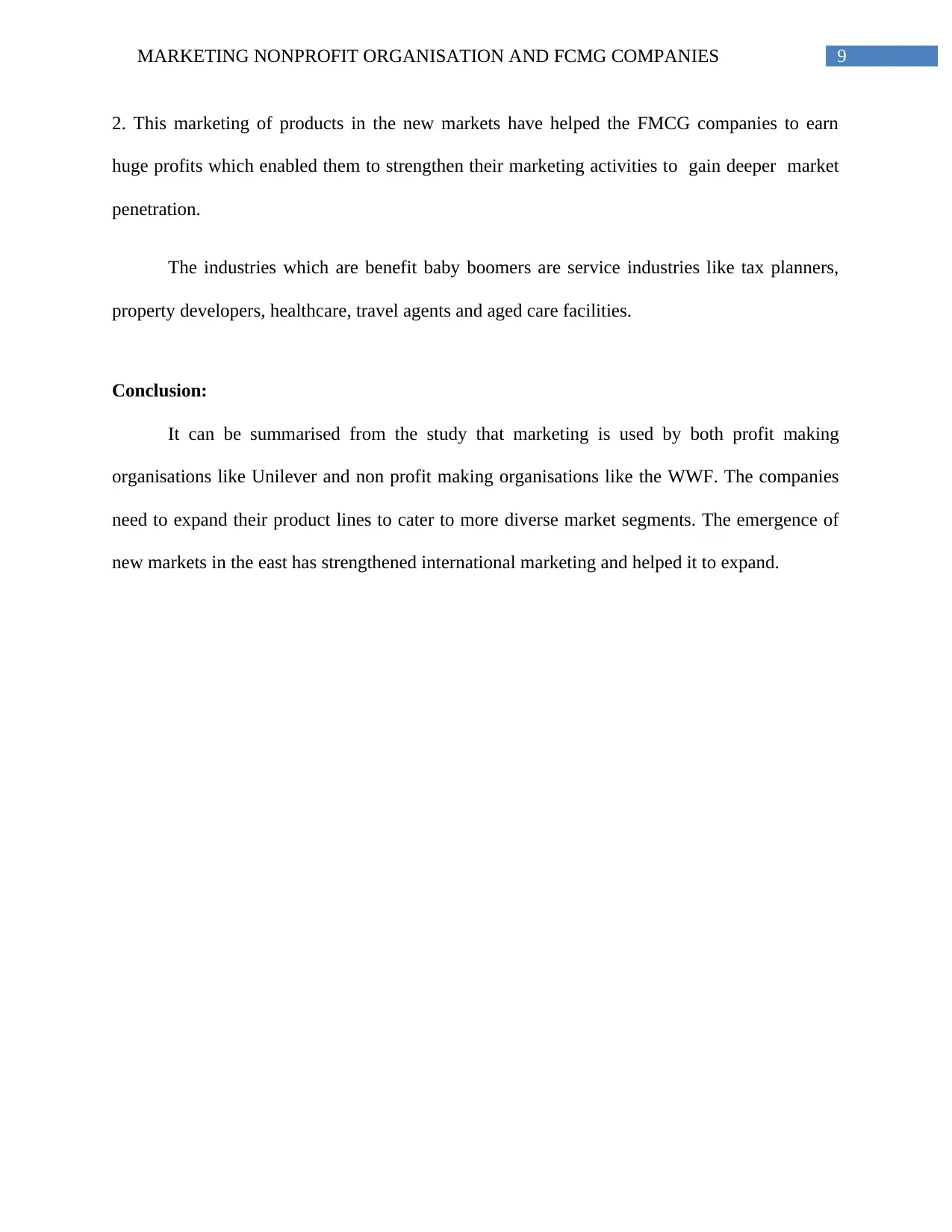
9MARKETING NONPROFIT ORGANISATION AND FCMG COMPANIES
2. This marketing of products in the new markets have helped the FMCG companies to earn
huge profits which enabled them to strengthen their marketing activities to gain deeper market
penetration.
The industries which are benefit baby boomers are service industries like tax planners,
property developers, healthcare, travel agents and aged care facilities.
Conclusion:
It can be summarised from the study that marketing is used by both profit making
organisations like Unilever and non profit making organisations like the WWF. The companies
need to expand their product lines to cater to more diverse market segments. The emergence of
new markets in the east has strengthened international marketing and helped it to expand.
2. This marketing of products in the new markets have helped the FMCG companies to earn
huge profits which enabled them to strengthen their marketing activities to gain deeper market
penetration.
The industries which are benefit baby boomers are service industries like tax planners,
property developers, healthcare, travel agents and aged care facilities.
Conclusion:
It can be summarised from the study that marketing is used by both profit making
organisations like Unilever and non profit making organisations like the WWF. The companies
need to expand their product lines to cater to more diverse market segments. The emergence of
new markets in the east has strengthened international marketing and helped it to expand.
Paraphrase This Document
Need a fresh take? Get an instant paraphrase of this document with our AI Paraphraser
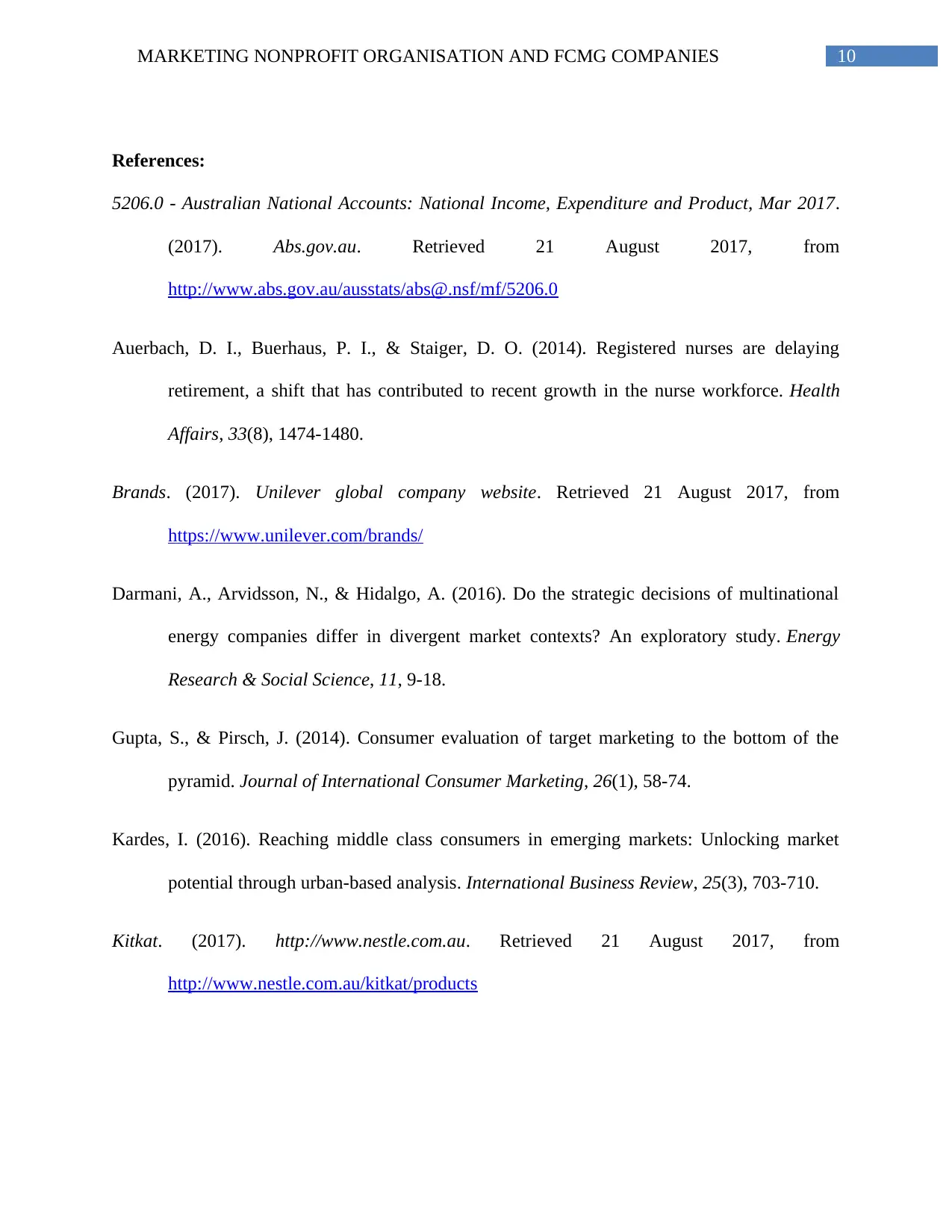
10MARKETING NONPROFIT ORGANISATION AND FCMG COMPANIES
References:
5206.0 - Australian National Accounts: National Income, Expenditure and Product, Mar 2017.
(2017). Abs.gov.au. Retrieved 21 August 2017, from
http://www.abs.gov.au/ausstats/abs@.nsf/mf/5206.0
Auerbach, D. I., Buerhaus, P. I., & Staiger, D. O. (2014). Registered nurses are delaying
retirement, a shift that has contributed to recent growth in the nurse workforce. Health
Affairs, 33(8), 1474-1480.
Brands. (2017). Unilever global company website. Retrieved 21 August 2017, from
https://www.unilever.com/brands/
Darmani, A., Arvidsson, N., & Hidalgo, A. (2016). Do the strategic decisions of multinational
energy companies differ in divergent market contexts? An exploratory study. Energy
Research & Social Science, 11, 9-18.
Gupta, S., & Pirsch, J. (2014). Consumer evaluation of target marketing to the bottom of the
pyramid. Journal of International Consumer Marketing, 26(1), 58-74.
Kardes, I. (2016). Reaching middle class consumers in emerging markets: Unlocking market
potential through urban-based analysis. International Business Review, 25(3), 703-710.
Kitkat. (2017). http://www.nestle.com.au. Retrieved 21 August 2017, from
http://www.nestle.com.au/kitkat/products
References:
5206.0 - Australian National Accounts: National Income, Expenditure and Product, Mar 2017.
(2017). Abs.gov.au. Retrieved 21 August 2017, from
http://www.abs.gov.au/ausstats/abs@.nsf/mf/5206.0
Auerbach, D. I., Buerhaus, P. I., & Staiger, D. O. (2014). Registered nurses are delaying
retirement, a shift that has contributed to recent growth in the nurse workforce. Health
Affairs, 33(8), 1474-1480.
Brands. (2017). Unilever global company website. Retrieved 21 August 2017, from
https://www.unilever.com/brands/
Darmani, A., Arvidsson, N., & Hidalgo, A. (2016). Do the strategic decisions of multinational
energy companies differ in divergent market contexts? An exploratory study. Energy
Research & Social Science, 11, 9-18.
Gupta, S., & Pirsch, J. (2014). Consumer evaluation of target marketing to the bottom of the
pyramid. Journal of International Consumer Marketing, 26(1), 58-74.
Kardes, I. (2016). Reaching middle class consumers in emerging markets: Unlocking market
potential through urban-based analysis. International Business Review, 25(3), 703-710.
Kitkat. (2017). http://www.nestle.com.au. Retrieved 21 August 2017, from
http://www.nestle.com.au/kitkat/products
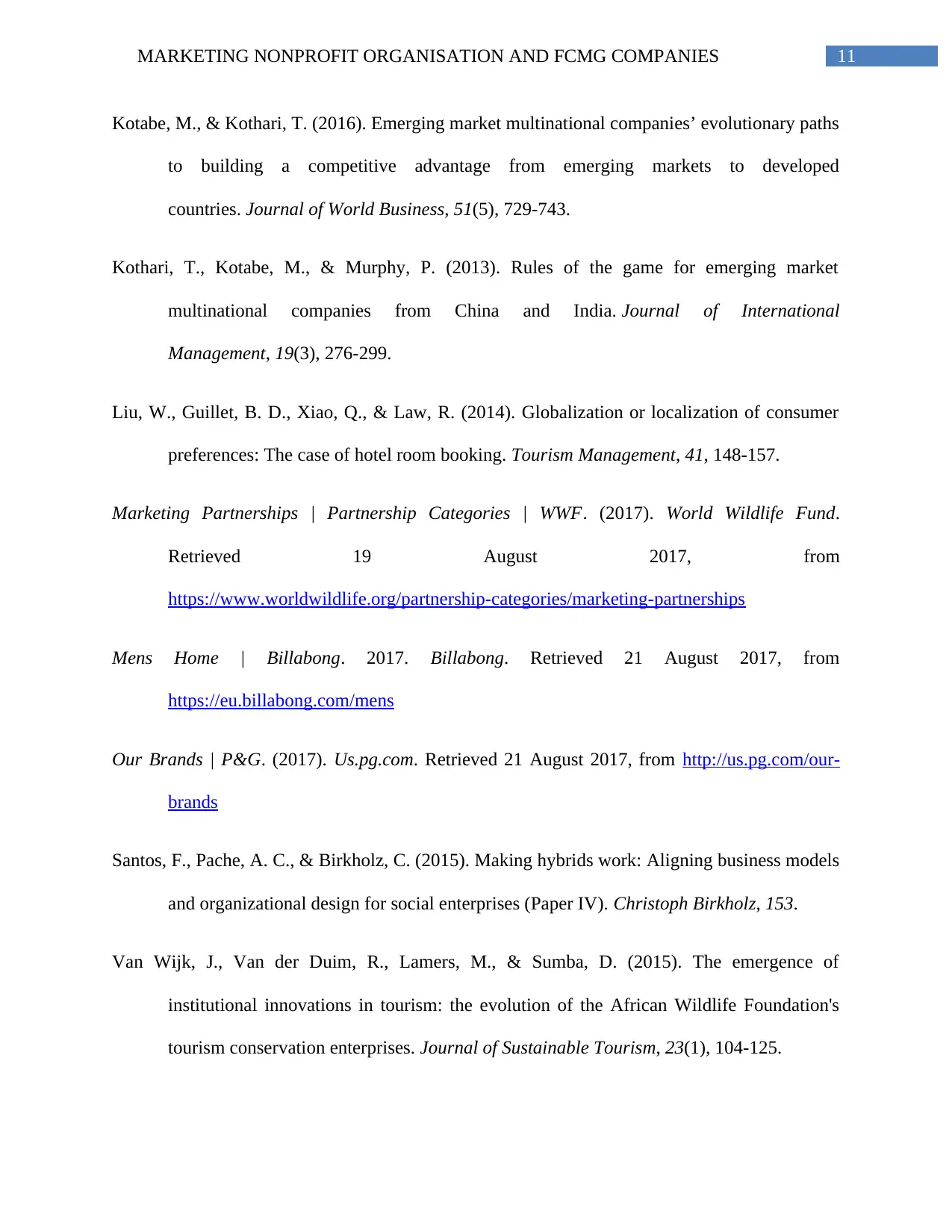
11MARKETING NONPROFIT ORGANISATION AND FCMG COMPANIES
Kotabe, M., & Kothari, T. (2016). Emerging market multinational companies’ evolutionary paths
to building a competitive advantage from emerging markets to developed
countries. Journal of World Business, 51(5), 729-743.
Kothari, T., Kotabe, M., & Murphy, P. (2013). Rules of the game for emerging market
multinational companies from China and India. Journal of International
Management, 19(3), 276-299.
Liu, W., Guillet, B. D., Xiao, Q., & Law, R. (2014). Globalization or localization of consumer
preferences: The case of hotel room booking. Tourism Management, 41, 148-157.
Marketing Partnerships | Partnership Categories | WWF. (2017). World Wildlife Fund.
Retrieved 19 August 2017, from
https://www.worldwildlife.org/partnership-categories/marketing-partnerships
Mens Home | Billabong. 2017. Billabong. Retrieved 21 August 2017, from
https://eu.billabong.com/mens
Our Brands | P&G. (2017). Us.pg.com. Retrieved 21 August 2017, from http://us.pg.com/our-
brands
Santos, F., Pache, A. C., & Birkholz, C. (2015). Making hybrids work: Aligning business models
and organizational design for social enterprises (Paper IV). Christoph Birkholz, 153.
Van Wijk, J., Van der Duim, R., Lamers, M., & Sumba, D. (2015). The emergence of
institutional innovations in tourism: the evolution of the African Wildlife Foundation's
tourism conservation enterprises. Journal of Sustainable Tourism, 23(1), 104-125.
Kotabe, M., & Kothari, T. (2016). Emerging market multinational companies’ evolutionary paths
to building a competitive advantage from emerging markets to developed
countries. Journal of World Business, 51(5), 729-743.
Kothari, T., Kotabe, M., & Murphy, P. (2013). Rules of the game for emerging market
multinational companies from China and India. Journal of International
Management, 19(3), 276-299.
Liu, W., Guillet, B. D., Xiao, Q., & Law, R. (2014). Globalization or localization of consumer
preferences: The case of hotel room booking. Tourism Management, 41, 148-157.
Marketing Partnerships | Partnership Categories | WWF. (2017). World Wildlife Fund.
Retrieved 19 August 2017, from
https://www.worldwildlife.org/partnership-categories/marketing-partnerships
Mens Home | Billabong. 2017. Billabong. Retrieved 21 August 2017, from
https://eu.billabong.com/mens
Our Brands | P&G. (2017). Us.pg.com. Retrieved 21 August 2017, from http://us.pg.com/our-
brands
Santos, F., Pache, A. C., & Birkholz, C. (2015). Making hybrids work: Aligning business models
and organizational design for social enterprises (Paper IV). Christoph Birkholz, 153.
Van Wijk, J., Van der Duim, R., Lamers, M., & Sumba, D. (2015). The emergence of
institutional innovations in tourism: the evolution of the African Wildlife Foundation's
tourism conservation enterprises. Journal of Sustainable Tourism, 23(1), 104-125.
⊘ This is a preview!⊘
Do you want full access?
Subscribe today to unlock all pages.

Trusted by 1+ million students worldwide
1 out of 13
Your All-in-One AI-Powered Toolkit for Academic Success.
+13062052269
info@desklib.com
Available 24*7 on WhatsApp / Email
![[object Object]](/_next/static/media/star-bottom.7253800d.svg)
Unlock your academic potential
Copyright © 2020–2025 A2Z Services. All Rights Reserved. Developed and managed by ZUCOL.